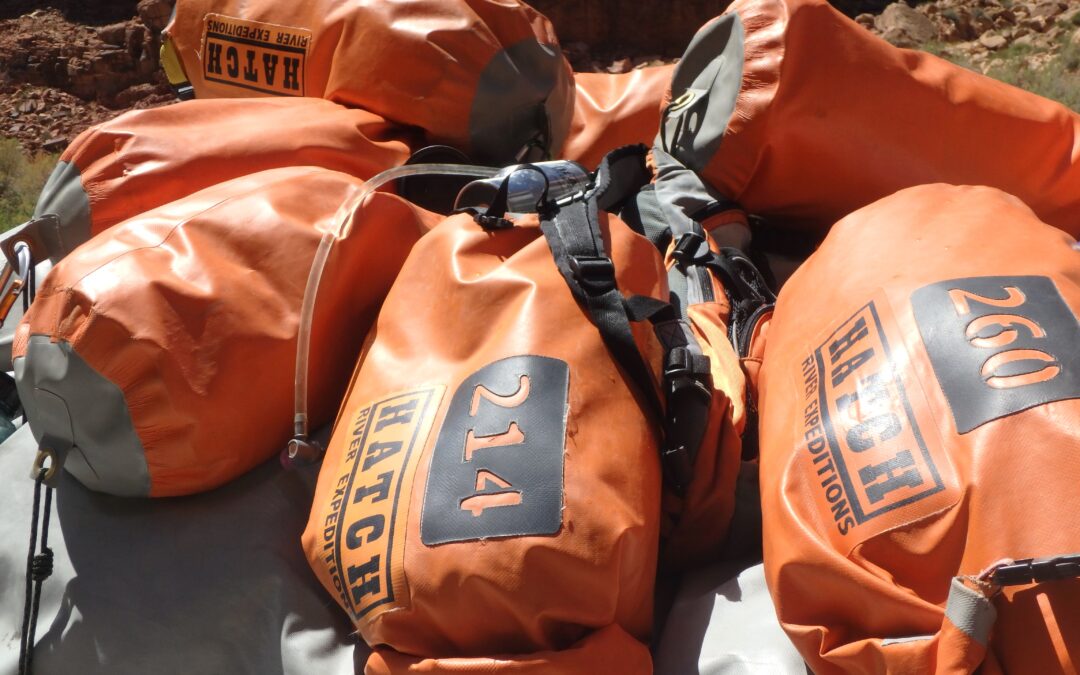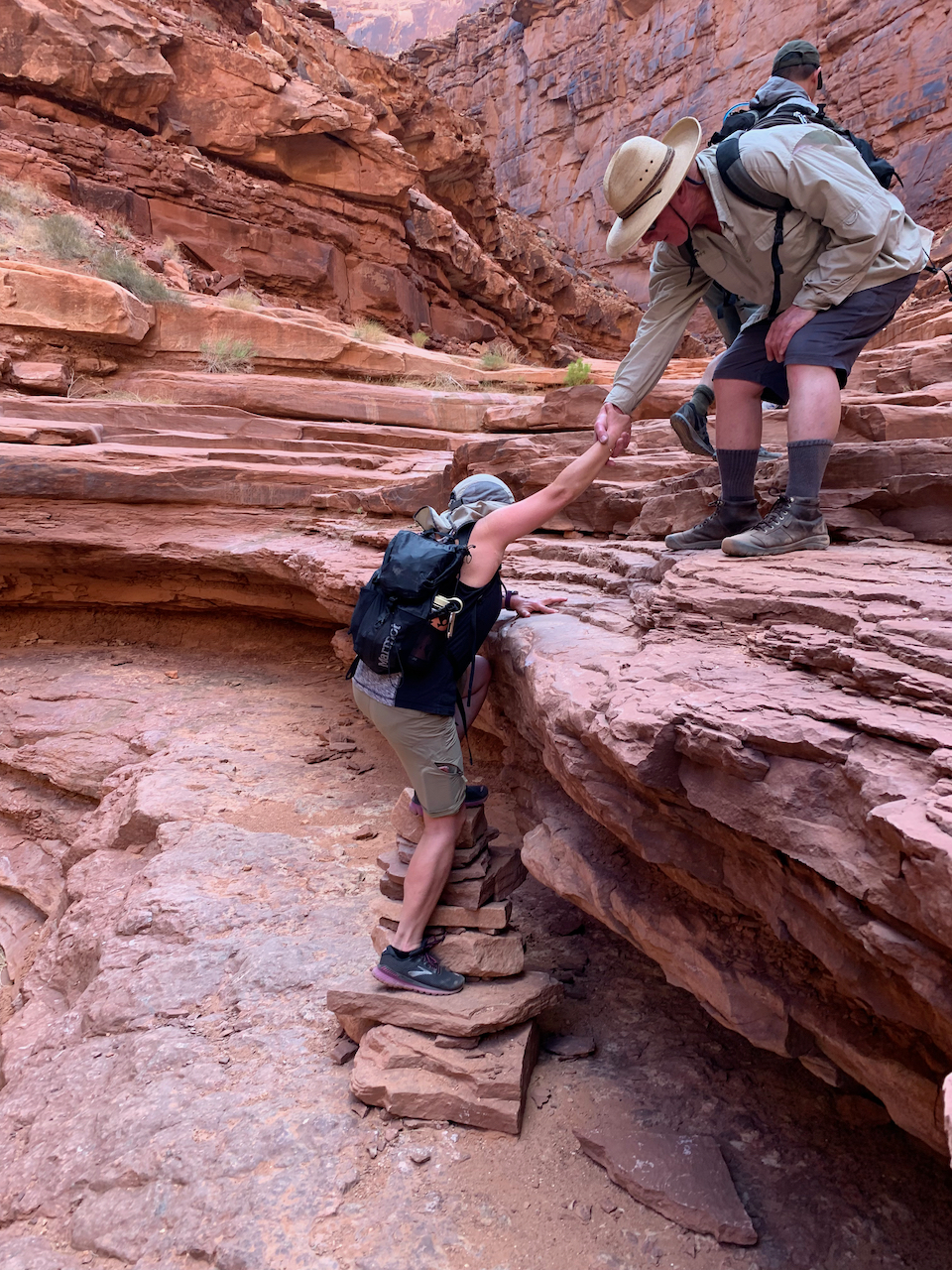Conditioning Activities to Prepare for Your Grand Canyon Rafting Trip
Rafting in the Grand Canyon with Hatch is an active vacation where your participation is an integral part of a smooth and successful trip.
We’ll cook your meals, but you’ll still need to set up your own tent. We’ll drive the boats, but you’ll help load and unload them. We’ll lead (optional) hikes to incredible places that are hard to get to, and you’ll keep pace with the group (if you choose to join). To maximize your experience of a lifetime, you should plan on putting in some time and energy before you reach the water. Here we’ll go through some ideas to physically prepare for your rafting trip.
If you’re joining us on the river, here are some of the physical activities you should be prepared for:
- hiking up the sides of the canyon; along narrow ledges; over and around boulders, trees, and cacti; and through running creek beds*
- balancing as you walk across the bobbing surface of the raft which may be hot or wet and slippery
- climbing onto and off of the raft (that can be 2-4 feet), sometimes onto a sandy beach, sometimes onto a rocky surface, and sometimes into shallow water
- being bounced and jostled through whitewater rapids, and keeping your body safely and securely aboard by holding onto rope handholds
- walking up sandy or rocky slopes and across uneven ground in camps
- helping unload gear from boats in fire-line style and carrying your own camping gear (up to 25 lbs worth) to your campsite
*Guests participating in hiking focused trips and upper/lower canyon trips should prepare for more intensive hikes that may be several miles and take multiple hours. Upper and lower canyon trips involve a mandatory hike on the unpaved Bright Angel Trail, which is up to 9 miles with 4,400ft (1,340m) of elevation change.
These activities take place whether it is hot or cold, raining or dry, windy or calm, so it’s important that you prepare accordingly for your trip. Although one long-time guest joked that the best preparation was to sleep outside in a sandy sleeping bag, we have a few more practical ideas!
Integrating Physical Activity into Your Everyday Living
We all have busy lives, so it can sometimes be difficult to imagine fitting additional activities into them. Here are 3 main approaches you can take:
- Modify things you already do so that they are more active
- Dedicate time specifically to exercise or physical activity
- Participate in hobbies or social activities that require more movement
Modify Things You Already Do
If you’re already going to be running an errand or going to work, try changing your routine a little so that it requires you to move more. Examples include:
- parking at the back of a parking lot and walking farther when you go to work or run errands
- carrying your groceries from the store to your car instead of using a cart (if you don’t have too many!)
- increasing the frequency or length of your dog walks or turn it into a jog
- walking or biking instead of driving to run errands close to your home
- if it’s a manageable distance, try biking to work
- using stairs instead of elevators in buildings
- do body weight exercises, use at-home weights, or get a walking pad to use while you watch TV
- go to the gym to (re)watch your favorite shows while you walk, run, or stair step
- choosing a steep path over a more gradual one when one is available
- running down hills or flat stretches when out for a walk
- try balancing on one foot or doing calf raises while you do the dishes, fold laundry or brush your teeth (balancing well also strengthens your brain [paywalled link])
- do a squat to pick things up instead of bending over, or modify it to a kickstand squat or pistol (single leg) squat
- find an exercise or few that you can do every time you go upstairs or downstairs at home
Dedicate Time Specifically to Exercise
- start using a treadmill at home or at the gym to get in the habit of walking
- set aside specific time in your schedule (maybe 30 minutes in the morning or after work a few days a week) to go for a walk or run
- use a stair climbing machine at the gym to simulate stepping up steep Grand Canyon trails
- use exercise bikes, treadmills, or other gym equipment for cardio workouts
- lift weights as part of your exercise routine to get used to lifting and carrying gear (which can be 25-35lbs.)
- go for a swim at your local pool or beach
- go for a bike ride around your neighborhood
- get a bike converter stand so you can turn it into an indoor stationary bike
- go for a day-hike with a full backpack (10-15lbs. for a daypack with a couple full 1L water bottles, or 25-30lbs. for a full backpack for upper or lower canyon trips)
Participate in Hobbies or Social Activities that Require Movement
- when socializing with friends, go for a walk instead of a drink or a meal
- go out dancing or find dance classes
- play tag with your kids or grandkids
- spend a weekend day going on a family hike and bring a picnic
- start a new habit of taking an after-dinner walk through the neighborhood
- lift and carry young kids or grandkids when you’re playing with them
- participate in a pick up sports game in your neighborhood
- start a new hobby that requires you to move your body such as gardening or yoga
- meet a friend at the gym at the same time(s) each week to socialize and be each other’s accountability buddies
- challenge the whole family to see who can do the most (squats, burpees, pushups, jump rope, etc.) or longest (plank, balance on one leg, etc.) on day 1 vs. day 30/60/90 or by a holiday
Expand Your Trip Preparation
As your trip gets closer, step up your activity levels even more. Try increasing the intensity, frequency, or duration of your activities:
- go for longer walks, runs, hikes, or bike rides
- find trails in your area with more difficult terrain, changing elevation, areas to scramble around rocks, or more rugged trail conditions (there’s no paved trails in Grand Canyon!)
- increase the difficulty of the routines you’re doing on your gym equipment (steeper, faster, or more elevation changes)
- spend more time being active (if you normally exercise for 15 minutes, increase it to 30; if you normally exercise twice a week, increase it to 3 times)
For most participants on full canyon trips, increasing physical activity in these small ways will be enough to make a huge difference. If you’re on a hiking focused trip or an upper/lower canyon trip, you may need to do more. For these trips, focus specifically on finding hiking trails in your area that feature rough terrain and elevation changes. Work on successfully completing longer hikes until you can comfortably do 6-8 miles in a day.
Other Ways to Prepare
Your body isn’t the only thing that needs conditioning.
- GEAR: Purchase and break in any gear you’ll be wearing (ESPECIALLY SHOES!) prior to joining us for your trip.
- MIND: Get used to paying attention to your needs. Drink when you are thirsty, eat salt when you are craving it, rest and stretch when your muscles are straining. This kind of self-awareness is critical to taking care of yourself on the river.
- ATTITUDE: Adopt a “go with the flow” mentality. At Hatch we call this “adventure attitude.” What you expect to happen in life and what actually takes place aren’t always the same thing. This is doubly true when you’re on the river, so be ready to adjust to changes in the plan as necessary.
We want you to enjoy your Grand Canyon trip to the max and being physically prepared before you reach the river will go a long way. If you’ve taken our suggestions above to heart and really put some time and energy into getting ready before your trip, we are confident that your vacation with Hatch River Expeditions truly will be the trip of a lifetime!

